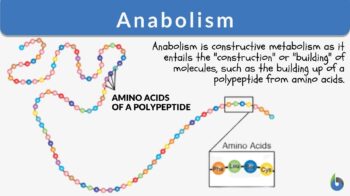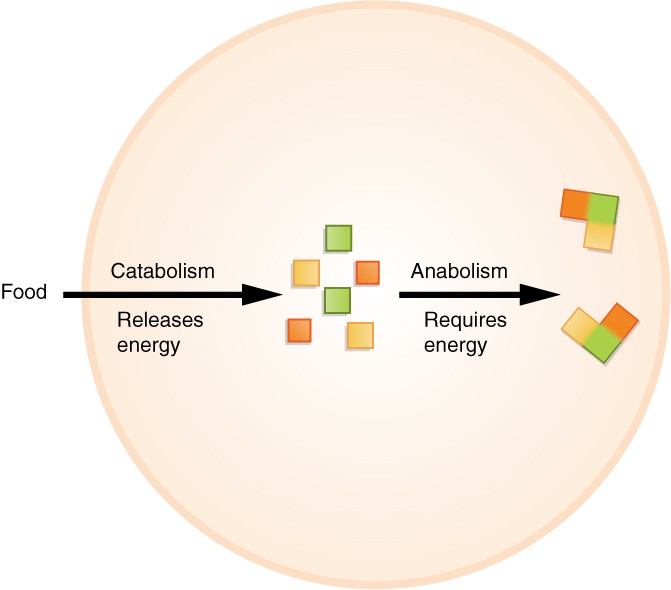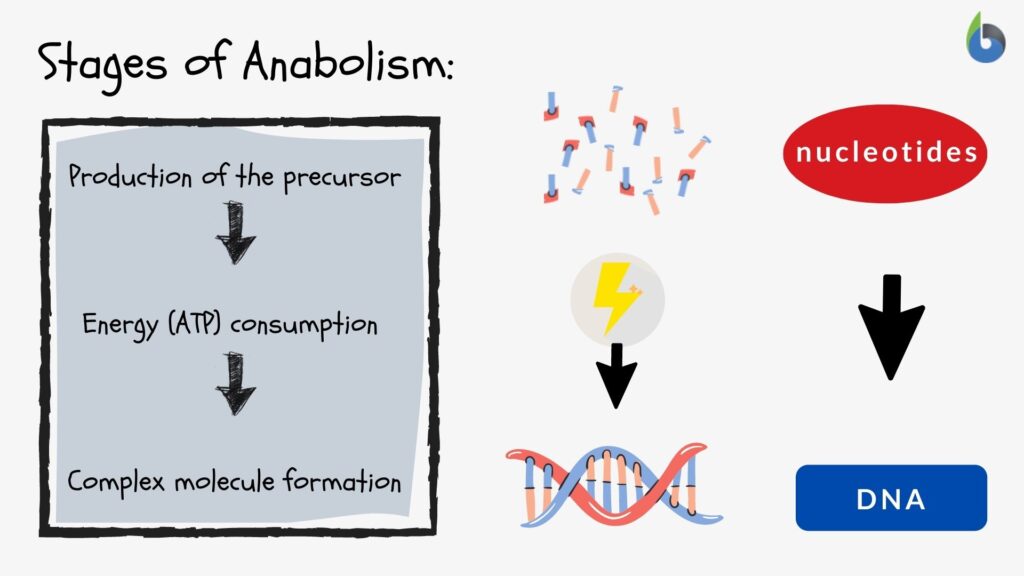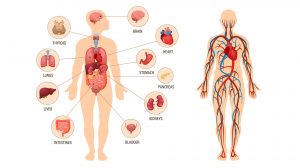
Anabolism
n., plural: Anabolisms
[ə.ˈnæ.bə.ˌlɪ.zəm]
Definition: constructive metabolism
Table of Contents
Anabolism Definition
Metabolic processes involve the conversion of one molecule into another through a sequence of chemical reactions which may consume or release energy. Metabolism involves different processes that maintain the normal function of the bodies of living organisms. It organizes the use of energy in the body as well as the availability of different molecules through different catabolic and anabolic biosynthetic pathways.
Metabolism is divided into two domains: catabolism and anabolism. Catabolism is the destructive type of metabolism. It is a process where large complex molecules are broken down into smaller ones releasing energy. For example, glycolysis involves producing energy from glucose derived from complex carbohydrate biomolecules.
What is anabolism? Anabolism (definition in biology) involves synthetic reactions of metabolism. It includes building up large complex molecules from simple molecules. The anabolic state represents the growth of muscles, bones, and other body structures.
Does anabolism require energy? It usually consumes energy through ATP hydrolysis. For example, the kidneys and liver can produce glucose from other sources than carbohydrates in a process known as gluconeogenesis.

Anabolism is the process involving a sequence of chemical reactions that constructs or synthesizes molecules from smaller units, usually requiring an input of energy (ATP) in the process. Etymology: Greek ἀνα- (ana-), meaning “up” and βάλλω (bállō), meaning “I throw” + -ism. Synonym: constructive metabolism. Compare: catabolism
Pathway
What does anabolism mean? Researchers define anabolism as a sequence of biochemical reactions involving building complex structures from smaller ones and they usually consume energy. Anabolism in living organisms includes synthesizing anabolic proteins from amino acid units, glucose from carbon dioxide molecules, and DNA from nucleotides.
Anabolic pathways are responsible for synthesizing essential molecules to the life and function of the body. An example of anabolic pathways is the food-manufacturing process in plants where sugar molecules are produced via a pathway known as photosynthesis. Plants consume energy obtained from sunlight to produce sugar molecules from carbon dioxide. Sugar molecules produced by the plant provide a source of energy for animals feeding on these plants.
Is it true that cellular respiration is an anabolic process? Cellular respiration is a catabolic process where the plant itself may consume the produced sugars to produce ATP molecules and obtain energy through catabolic pathways.
Stages of Anabolism
Anabolism is divided into three stages. They are:
Stage 1: Precursor formation
The precursors used to build larger molecules, such as amino acids, monosaccharides, isoprenoids, and nucleotides, are produced.
Stage 2: Energy consumption
Energy obtained from ATP is used to activate the precursor from stage 1 into a reactive precursor to participate in the next biochemical reactions.
Stage 3: Complex molecule formation
This stage entails the formation of complex large molecules such as proteins, polysaccharides, lipids, and nucleic acid from their active precursors.

Energy Source
Anabolism is a process that consumes energy. The used energy is obtained from cellular respiration which is a catabolic process to produce ATP. Energy is used in anabolism to activate precursors or to join them together. Energy sources vary where reactions in plants require energy from sunlight whereas chemoheterotrophs obtain energy from oxidation reactions of inorganic substances. The chemoheterotrophic definition includes organisms that are capable of producing their own sources of energy using inorganic substances as substrates for anabolic processes.
Cofactors
Different steps in anabolic reactions require the presence of cofactors and metal ions to catalyze various reactions through anabolism. Reducing agents such as NADH, FADH, and NADPH carry electrons during chemical reactions while metal ions stabilize various functional groups present on substrates.
Substrates
Substrates in anabolism are usually products of catabolic processes when energy is abundant in the cell. Anabolism substrates are usually small simple molecules such as amino acids, nucleotides, and monosaccharides.
Functions
Anabolism (medical definition) includes processes that mediate the growth and development of living organisms. The differentiation of cells and the increase in the size of the body occur as a result of different anabolic processes. Anabolic functions build different tissues and organs. They also increase the size of muscle as well as bones.
Anabolic hormones
Hormones are either catabolic or anabolic depending on the stimulated part of metabolism. The most important anabolic hormones are insulin, growth hormone, estrogen, and testosterone. Insulin hormone stimulates the synthesis of skeletal muscles, lipids, and glycogen, while steroids and growth hormones increase the total body mass by accelerating protein anabolism in the body.
Photosynthetic carbohydrate synthesis
Photosynthetic carbohydrate synthesis is an anabolic process that takes place in certain bacteria and in plants. It produces starch, glucose, cellulose, proteins, and lipids from carbon dioxide using the energy derived from light reactions during photosynthesis. In this process, organic acids are converted into monosaccharides and then they are used to synthesize polysaccharides, such as starch.
READ: Plant Metabolism – Photosynthesis (Biology Tutorial)
Amino acid biosynthesis
There are 20 amino acids in the body. During protein synthesis, amino acids are attached together by peptide bonds. Intermediates obtained from the catabolic pathways of the pentose phosphate pathway, the citric acid cycle, and glycolysis are used in amino acid synthesis.
For example:
- The precursor for histidine amino acid is glucose-6-phosphate that is obtained from glycolysis
- A common precursor of valine, alanine, and leucine is pyruvate from the citric acid cycle
- The oxaloacetate is used in synthesizing methionine, lysine, threonine, aspartate, and asparagine
Glycogen storage
Glucose is stored in the form of glycogen. Glycogen is a large complex polymer of glucose molecules. Glycogen is synthesized through the anabolic pathway and is broken down again when the body needs energy through catabolic pathways. When the blood sugar is high, glycogen synthase is activated; it produces glycogen to be stored in the liver and skeletal muscles. In periods of low blood sugar, glycogen serves to maintain the level of blood glucose to provide the brain with adequate nutrition.
Gluconeogenesis
What is gluconeogenesis? Gluconeogenesis is an anabolic process where glucose is produced from non-carbohydrate sources. It is stimulated by the glucagon hormone. Gluconeogenesis takes place during prolonged starvation by the liver, kidney, and intestines to maintain blood glucose levels.
In gluconeogenesis, pyruvate is converted into glucose. Pyruvate is obtained from the breakdown of amino acids, lactate, glycerol, or glucose. Gluconeogenesis is the reverse of glycolysis but it uses different enzymes that proceed in one direction only.
Gluconeogenesis net reaction is:
2 pyruvate + 2 GTP + 4 ATP + 2 NADH + 6 H2O + 2 H+ → Glucose + 2 GDP + 4 ADP + 2 NAD+ + 6 Pi
Examples of Anabolism
Anabolic processes are responsible for building up and synthesizing molecules. Examples of anabolic processes are mineralization and growth of bones and muscle anabolism, which helps in building up the muscle mass of the body. Moreover, anabolism (definition in anatomy) includes synthesizing macromolecules such as proteins, glycogen, amino acids, and polysaccharides to maintain the normal function of different body organs.
Regulation
Anabolism is regulated by different hormones and enzymes. Anabolic enzymes are different from catabolic enzymes, which proceed in one direction only to control the rate of anabolic and catabolic processes. Another regulator of anabolic and catabolic processes is ATP or energy charge in the cell. Cells with high energy favor anabolic pathways to consume ATP in production and storage. Low ATP levels stimulate catabolic processes to break large molecules in order to generate ATP.
Anabolism vs. Catabolism
Metabolism pertains to all the chemical reactions involved in modifying a molecule into another. It may be grouped into two: catabolic reactions (catabolism) and anabolic reactions (anabolism).
Table 1: Differences between anabolism and catabolism |
|
|---|---|
| Anabolism | Catabolism |
| Anabolism pertains to a sequence of chemical reactions that constructs or synthesizes molecules from smaller units. | Catabolism includes a series of degradative chemical reactions that break down complex molecules into smaller units. |
| Anabolic reactions usually require an input of energy. Many of these reactions are fueled through the hydrolysis of ATP. | Catabolic reactions often release energy in the process. |
| Anabolism is for the synthesis of complex molecules essential in the building up of organs and tissues. It is therefore responsible for the increase in body size. | Catabolism is for degrading complex molecules that essentially provide simple molecules and/or release energy that can be used for other metabolic processes |
| Examples of anabolism are bone growth mineralization and muscle mass build-up. | Breakdown of proteins to amino acids, glycogen to glucose, and triglycerides to fatty acids are some of the catabolic processes. |
Hormones are typically classified as either anabolic or catabolic based on their effect on the metabolic processes. Anabolic hormones are estrogen, testosterone, growth hormones, and insulin. Catabolic hormones are adrenaline, glucagon, cortisol, etc.
Try to answer the quiz below to check what you have learned so far about anabolism.
References
- Berg, J. M. (1970, January 1). Glycogen Metabolism. Biochemistry. 5th edition. https://www.ncbi.nlm.nih.gov/books/NBK21190/.
- Encyclopædia Britannica, inc. (n.d.). Anabolism. Encyclopædia Britannica. https://www.britannica.com/science/anabolism.
- Libretexts. (2021, March 6). B. MP2: An Overview of Metabolic Pathways – Anabolism. Biology LibreTexts. https://bio.libretexts.org/Bookshelves/Biochemistry/Book%3A_Biochemistry_Online_(Jakubowski)/10%3A_Metabolic_Pathways/B._MP2%3A_An_Overview_of_Metabolic_Pathways_-_Anabolism.
- Mandal, D. A. (2019, February 26). What is Anabolism? News. https://www.news-medical.net/life-sciences/What-is-Anabolism.aspx.
- Structural Biochemistry/Anabolism. Wikibooks, open books for an open world. (n.d.). https://en.wikibooks.org/wiki/Structural_Biochemistry/Anabolism.
©BiologyOnline.com. Content provided and moderated by Biology Online Editors.



